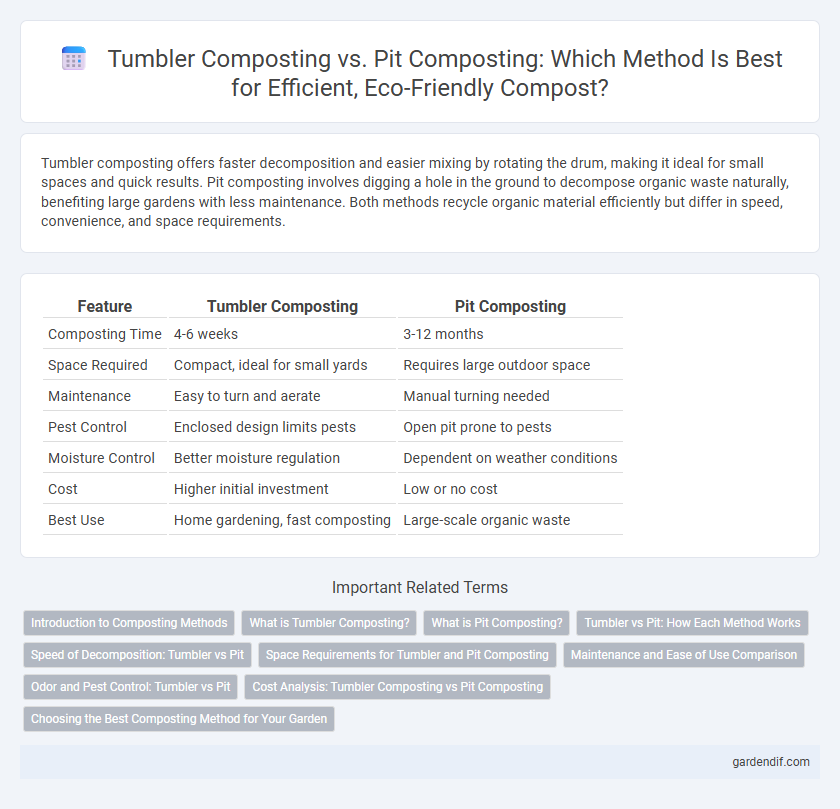
Tumbler Composting vs Pit Composting Illustration
Tumbler composting offers faster decomposition and easier mixing by rotating the drum, making it ideal for small spaces and quick results. Pit composting involves digging a hole in the ground to decompose organic waste naturally, benefiting large gardens with less maintenance. Both methods recycle organic material efficiently but differ in speed, convenience, and space requirements.
Table of Comparison
| Feature | Tumbler Composting | Pit Composting |
|---|---|---|
| Composting Time | 4-6 weeks | 3-12 months |
| Space Required | Compact, ideal for small yards | Requires large outdoor space |
| Maintenance | Easy to turn and aerate | Manual turning needed |
| Pest Control | Enclosed design limits pests | Open pit prone to pests |
| Moisture Control | Better moisture regulation | Dependent on weather conditions |
| Cost | Higher initial investment | Low or no cost |
| Best Use | Home gardening, fast composting | Large-scale organic waste |
Introduction to Composting Methods
Tumbler composting uses a sealed, rotating container that aerates organic waste efficiently, speeding up decomposition and reducing odors. Pit composting involves digging a hole in the ground to bury organic matter, allowing natural microbial activity to break down materials over time with minimal maintenance. Both methods support soil enrichment but differ significantly in speed, space requirements, and user involvement.
What is Tumbler Composting?
Tumbler composting involves using a sealed, rotating container designed to aerate and mix organic waste efficiently, speeding up decomposition. This method reduces odors and pest issues compared to traditional pit composting by maintaining better airflow and moisture control. Tumblers are ideal for small spaces and urban gardeners seeking a quicker, more manageable composting process.
What is Pit Composting?
Pit composting is a simple method of decomposing organic waste by burying it in a dug-out pit, often measuring around 1 to 2 feet deep, where microbial activity breaks down the materials into nutrient-rich compost. This low-cost technique requires minimal equipment and is ideal for small-scale composting of kitchen scraps, garden waste, and biodegradable organic matter. Pit composting relies on maintaining proper moisture and aeration to accelerate decomposition and prevent odor issues, making it an accessible option for gardeners and households.
Tumbler vs Pit: How Each Method Works
Tumbler composting involves rotating a sealed drum to aerate and mix organic waste, speeding up decomposition through improved oxygen flow and moisture control. Pit composting requires digging a hole or trench where organic materials decompose anaerobically over time without disturbance, relying on natural microbial activity and slower breakdown processes. The key difference lies in tumblers offering faster, controlled composting with minimal effort, while pits are low-cost but slower and less manageable.
Speed of Decomposition: Tumbler vs Pit
Tumbler composting accelerates the speed of decomposition by providing consistent aeration and easy turning, which enhances microbial activity and breaks down organic material in as little as 4 to 6 weeks. In contrast, pit composting relies on natural microbial processes with limited oxygen flow, resulting in slower decomposition that can take several months to a year. The continuous agitation in tumblers significantly reduces composting time compared to the passive nature of pit composting.
Space Requirements for Tumbler and Pit Composting
Tumbler composting requires significantly less space, making it ideal for small gardens or urban environments, with compact bins typically occupying less than 3 square feet. Pit composting demands more space as it involves digging a sizable hole or trench, often at least 2 to 3 feet deep and wide, suitable for larger yard areas. Efficient aeration in tumblers enhances decomposition speed while pits rely on natural soil microbes and moisture levels, influencing spatial planning.
Maintenance and Ease of Use Comparison
Tumbler composting requires regular turning by rotating the container, making it easier to maintain consistent aeration and faster decomposition. Pit composting demands manual aeration efforts like mixing or digging, which can be labor-intensive and time-consuming. Tumbler systems tend to be more user-friendly and clean, while pit composting suits those with limited space but higher maintenance tolerance.
Odor and Pest Control: Tumbler vs Pit
Tumbler composting offers superior odor control by ensuring consistent aeration and faster decomposition, which minimizes anaerobic conditions that cause foul smells. Pit composting often struggles with odor issues due to poor airflow and slower breakdown of organic matter, attracting pests such as rodents and flies. The enclosed design of tumblers also provides an effective barrier against pests, unlike open pits that are more accessible to unwanted wildlife.
Cost Analysis: Tumbler Composting vs Pit Composting
Tumbler composting systems typically involve higher initial investments, ranging from $50 to $200 for durable plastic or metal models, whereas pit composting requires minimal to no upfront costs, often limited to simple tools or digging equipment. Operational expenses for tumbler composting include occasional maintenance and potential replacement parts, while pit composting demands labor-intensive management but no significant ongoing expenses. Considering long-term cost-effectiveness, pit composting offers a budget-friendly solution despite greater manual labor, whereas tumblers provide convenience and faster decomposition at a premium price.
Choosing the Best Composting Method for Your Garden
Tumbler composting accelerates decomposition through regular aeration and temperature control, making it ideal for small gardens seeking faster nutrient-rich compost. Pit composting is a low-maintenance, cost-effective method suited for larger outdoor spaces where gradual organic matter breakdown enriches soil naturally. Selecting the best method depends on garden size, available time, and desired composting speed, ensuring efficient nutrient recycling tailored to specific gardening needs.
Tumbler Composting vs Pit Composting Infographic

 gardendif.com
gardendif.com